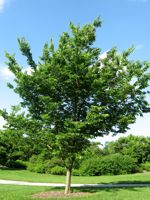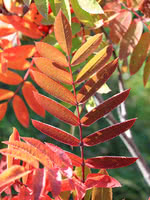Mon-Fri 9am - 5pm Mountain time
Common Hackberry vs American Mountain Ash
Celtis occidentalis
Sorbus americana
NOT AVAILABLE THIS SEASON - MIGHT RETURN
(new stock expected: fall of 2027)
The Common Hackberry is a medium-sized deciduous tree that resembles the American Elm but is immune to Dutch Elm Disease. They are versatile and can adapt to a variety of growing conditions.
It produces purple-red, berry-like fruit with a large seed in the center. Both the sweet flesh, which tastes similar to dates, and the crunchy seed are edible. The fruit remains on the tree throughout the winter, offering a valuable food source for birds and other wildlife.
The Common Hackberry can also be a great addition to a pollinator garden. The tree itself is a host for the larvae of several butterfly species and the flowers provide a source of pollen and nectar.
American Mountain ash is a beautiful, medium-sized ornamental tree that is ideal for residential lots. Mountain Ash blooms with tiny white flowers in the spring, followed by clusters of small red/orange berries in the summer.
American Mountain Ash's berries stay on the tree throughout the winter. This attracts birds and other small wildlife to your landscape as the berries are an important food source during the winter months.

